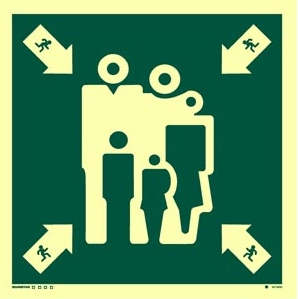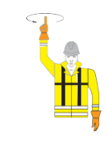Title Page
-
Conducted on
-
Position applied for
- Master
- Chief Officer
- Second Officer
- Third Officer
- Chief Engineer
- Second Engineer
- Third Engineer
- Fourth Engineer
- Bosun
- Able Seaman
- Ordinary Seaman
- Motorman
- Oiler
- Fitter
- Cook
- Second Cook
- Purser
- Hotel Staff
-
Candidate Name
-
Location
Skill Assessment Tool - please note that you are not required to add any attachments, notes, photographs or actions
SAFETY
-
Where do you expect to find information on the location of emergency equipment on board?
-
What do you understand by monitoring hours of work and rest and why is this important?
-
Who is responsible for safety?
-
You witness a colleague carrying out a task in a hazardous manner, what do you do?
-
You have an incident on board, what do you do?
-
During a voyage, you learn that heavy weather is expected at your vessel location in 4 hours time. What preparations do you make on deck? Please select all that apply:
- Inform the master
- Check lashings to cargo, lifeboats, liferafts, stores
- Check hatches secure
- Close off and cover vents if possible
- Rig lifelines
- Ensure watertight doors are closed
- Freeing ports functioning
- Cargo gear, stores cranes secure
- Reduce free surface effects in tanks
- Ensure spurling pipe covers secured
- Fir deadlights
- Inform galley staff and crew
- Monitor heavy weather reports
- Amend passage plan if necessary
- Log weather conditions
- Consider change of course/speed
- All of the above
What do the following symbols and signals mean?
-
-
-
-
Seven short blasts followed by one prolonged blast on the ship whistle
-
Master's verbal command to Abandon Ship
-
Three prolonged blasts on the ship whistle
-
Continuous ringing of the bell
You notice a person falling overboard (MOB). What are the immediate actions to be taken?
-
BRIDGE: Put the following in correct order.
-
-
-
-
-
-
DECK: put the following in correct order.
-
-
-
-
-
Safe systems of working practices
-
What processes should be included in an assessment prior to enclosed space entry / working aloft / over side / working on pressurised systems?
-
What equipment must be on standby when performing an enclosed space entry? Please select all of the correct answers.
- i) A person on standby outside the space with a radio
- ii) A device for monitoring the atmosphere in the enclosed space.
- iii) Breathing Apparatus (BA) set
- iv) Rescue devices
- v) First aid kit and resuscitation equipment
- vi) None of the above
-
During which task(s) must electrical isolation take place?
- i) Working aloft on the monkey island
- ii) Hot work
- iii) Work on high pressure systems
- iv) work on switchboard
- v) Maintenance work on machinery
- vi) All of the above
-
Detail the procedure required when isolating an electrical system. Put the following into the correct order.
-
- • Inform Chief Engineer
- • Safety locks on equipment to be placed
- • Isolation certificate to be provided and attached permit to work.
- • Risk assessment to be carried out
- • ETO to ensure fuses removed/circuit breakers opened to ensure all related circuits are dead.
- • Caution / danger notices to not use equipment once confirmed isolated for duration of permit to work to be posted at all points of isolation.
-
- • Inform Chief Engineer
- • Safety locks on equipment to be placed
- • Isolation certificate to be provided and attached permit to work.
- • Risk assessment to be carried out
- • ETO to ensure fuses removed/circuit breakers opened to ensure all related circuits are dead.
- • Caution / danger notices to not use equipment once confirmed isolated for duration of permit to work to be posted at all points of isolation.
-
- • Inform Chief Engineer
- • Safety locks on equipment to be placed
- • Isolation certificate to be provided and attached permit to work.
- • Risk assessment to be carried out
- • ETO to ensure fuses removed/circuit breakers opened to ensure all related circuits are dead.
- • Caution / danger notices to not use equipment once confirmed isolated for duration of permit to work to be posted at all points of isolation.
-
- • Inform Chief Engineer
- • Safety locks on equipment to be placed
- • Isolation certificate to be provided and attached permit to work.
- • Risk assessment to be carried out
- • ETO to ensure fuses removed/circuit breakers opened to ensure all related circuits are dead.
- • Caution / danger notices to not use equipment once confirmed isolated for duration of permit to work to be posted at all points of isolation.
-
- • Inform Chief Engineer
- • Safety locks on equipment to be placed
- • Isolation certificate to be provided and attached permit to work.
- • Risk assessment to be carried out
- • ETO to ensure fuses removed/circuit breakers opened to ensure all related circuits are dead.
- • Caution / danger notices to not use equipment once confirmed isolated for duration of permit to work to be posted at all points of isolation.
-
- • Inform Chief Engineer
- • Safety locks on equipment to be placed
- • Isolation certificate to be provided and attached permit to work.
- • Risk assessment to be carried out
- • ETO to ensure fuses removed/circuit breakers opened to ensure all related circuits are dead.
- • Caution / danger notices to not use equipment once confirmed isolated for duration of permit to work to be posted at all points of isolation.
Enclosed space entry
-
What characteristics might define an enclosed space?
-
What spaces on a vessel might be considered enclosed/confined?
-
Would you use an Emergency Escape Breathing Device (EEBD) for emergency response in enclosed space rescue?
Management of change/modifications
-
To enable extra storage on board the master authorises the loading of a container on board which will be used to contain stores/supplies. What, if any criteria need to be considered?
-
The master should complete and submit the management of change request form, the stability of the vessel would need to be recalculated to confirm that the addition of the container is safe; Flag and/or Class as appropriate would need to authorize such an addition to a ship, amending and approving the stability booklet
-
The container sounds to be quite light and should not affect the stability of the vessel, as long as the master is satisfied; nothing further needs to be done.
-
The master needs to send an email to the office ashore telling them what the plan is. As long as this has been done, the Master can proceed as he sees fit.
-
To enable a fix to a piece of machinery, the engineer needs to use a modified part. What needs to be done before using the modified part?
Vessel familiarisation
-
What are the key areas to familiarise yourself with when joining a new vessel?
- Location of muster station
- Muster duties
- Location of LSA/FFA
- Complete the company familiarization form
- Job role and responsibilities
- Equipment used in your job role
- Company procedures
- All of the above
Working on board
-
You have been asked to carry out a task that is new to you. How do you prepare?
- a) Identify/review the relevant sections in company procedures
- b) Prepare a risk assessment
- c) Consult equipment manual if applicable
- d) Consult with other crew members as applicable
- e) All of the above
Communication equipment
-
a) How would you test the GMDSS equipment and how often?
-
b) Explain how the EPIRB activates automatically and precautions to be taken to prevent false alerts. Select all that apply
- EPIRBs are water activated, once the hydro static release mechanism has been initiated.
- There is a switch on the EPIRB that should activate the unit.
- EPIRBs are always transmitting data about the vessel location and so are always activated.
- No action is required if the EPIRB is accidently activated.
- EPIRBS are registered with an appropriate authority. Contact the authority the EPIRB is registered with to say it was a false alarm.
- The local maritime authority should be informed if the EPIRB is accidently activated
-
c) Explain the routine checks and tests to be carried out on a SART.
Third party workers
-
A third party contractor arrives on board to carry out a repair:
-
What should happen prior to them carrying out their task?
-
What oversight would you expect to give whilst they are working on board?
Fire safety
-
The fire heads are not working in the galley, what control measures should be implemented until the system is fixed?
-
There is a fire on board. Describe what action would be taken.
-
You notice that the galley fire blanket is not in its casing, you cannot see it. What do you do?
-
What is the International ship to shore connection?
Risk assessment
-
What is a risk assessment?
-
When should a risk assessment be undertaken?
Safety equipment
-
When carrying out maintenance checks of a lifejacket, what would you consider?
-
What checks and tests should be undertaken on a BA set, including gas bottles?
-
Explain the stowage/securing arrangement of a hydrostatic life raft
-
How and when would you use a smoke float?
SECURITY
-
What security measures should be undertaken in port? Please select all that apply:
- As per the Security Level of the Ship and Port (whichever is higher), follow guidance in Ship Security Plan.
- Make sure a person is posted at the gangway if the security levels is higher than normal
- The ship only needs to maintain its own security measures
- All of the above
-
When entering an area which is prone to piracy attacks:
-
What preparations do you make on board?
- Consult Ship Security Plan
- Best Management Practices (BMP5)
- Complete a Risk Assessment
- Comply with the area’s reporting requirements
- Use navigation lights only
- post more lookouts
- set up deterrents such as barbed wire etc as appropriate and feasible
- prepare water/foam hoses
- prepare citadels (where applicable)
- All of the above
-
Where could you get advice on pirate activity in the area?
-
What aspects should you consider to protect the vessel from a cyber hack?
- Security of a responsibility for the computer system on board the vessel lies with the office ashore and we don’t need to do anything on board the ship.
- A vessel specific cyber security plan to be prepared and shared with staff to promote cyber awareness on board.
- Refer to the relevant IMO guidelines/circulars bearing in mind that ‘Maritime Cyber Risk Management’ in the Safety Management Systems is soon to become mandatory on applicable ships.
- Ensure password protection is in place and updated regularly.
- Ensure virus protection is up to date and appropriate software updates applied.
- Perform regular back-ups.
- Ensure there is a procedure in place to check files on external media such as USB sticks and drives, DVD’s and CD’s before connecting to electronic devices.
- Emails must be scanned for suspicious attachments.
- Keep the minimum or even nil computers on the same network as that of the ship’s main communication computer(s)/ ships equipments.
- Possibly have a separate network for personal/common computers on board and for the ship’s main communication computer(s).
- Software updates of ship equipments such as ECDIS etc to be controlled and only via safe and designate sources.
NAVIGATION
Master/Pilot exchange (MPX)
-
If you disagree with an order from the pilot, what would you do?
-
What would you as a duty officer do when you see a pilot’s orders deviating the vessel from the passage plan?
-
List six criteria which should be included in the master/pilot exchange?
Weather
-
A sudden drop in barometric pressure indicates that the vessel may be approaching a storm.
-
Describe what action is required in the event that there is a sudden drop in barometric pressure?
-
How do you predict fog or recognize when you may be approaching an area of restricted visibility?
Watchkeeping
-
What are some of the things that you would consider to ensure the maintenance of a safe watch?
-
Detail the process of handing over/taking over the navigation watch
-
During a night time watch a navigation aid that you are not familiar with starts to alarm, what do you do?
-
In the event that you are maintaining a navigational watch, and become unwell, what action should you take?
-
When performing a navigation watch, when would you call the master?
-
What should be included in the bridge log book during arrival/departure at a port?
-
Detail some of the factors you consider to ensure a safe anchor watch?
-
Describe some of the key elements that you would expect to be included in a pre-arrival and/or pre-departure checklist?
Vessel Data Recorder
-
In the event of an emergency, what is the emergency procedure for downloading information from the VDR?
-
In the event of a non-catastrophic incident …
-
In the event of a catastrophic incident …
Celestial navigation
-
How often should one ideally complete the compass error?
-
Give three examples of when the magnetic compass should be swung and deviation card revised?
International Regulations for Preventing Collisions at Sea (ColRegs) - OOW +
-
What action should you take if you view a vessel with incomprehensible lights?
-
Describe how to maintain a proper lookout.
-
What actions should be taken in case of approaching restricted visibility?
-
Overtaking situation – what are the responsibilities of the vessels?
-
The overtaking vessel is required to …
-
The vessel being overtaken is required to …
-
Head on situation with two power driven vessels: what are the responsibilities of the vessels where it has been established that a risk of collision exists?
-
Each vessel shall …
-
A close quarters situation is developing involving a vessel restricted in ability to manoeuvre and a vessel constrained by draught. What are the responsibilities of the respective vessels?
-
A vessel constrained by draught shall …
-
The vessel restricted in the ability to manoeuvre…
What do the following navigation lights show:
Chartwork
Correcting navigation charts
-
It is acceptable for me to correct charts when I am in charge of a navigational watch
-
I identify which of the Notices to Mariners (NTM) applies to charts within the vessel’s chart folio
-
A fine tip magenta pen is not necessary, I can correct charts with anything that is available, such as a ball point pen
-
I remove old information/corrections from the chart before applying new corrections
-
I apply the correction to the chart, referring to NP294 where necessary
-
Notices may come in the form of color blocks where there are a number of corrections
-
After applying the correction, I note the NTM number in the bottom left-hand side of the chart
-
There is no need to record in a log the corrections that have been made as they can be seen on the chart
-
How often do you correct charts?
-
How do you ensure the voyage charts are corrected up to date?
-
How often are NTMs released and where can they be found?
-
How are condemned charts dealt with?
-
How are T&P notices corrected?
-
Who is responsible for ensuring chart corrections are being properly completed?
-
The officer or crew member designated to carry out chart maintenance is responsible for...
-
The master shall...
-
The company is responsible for...
What do these chart symbols represent?
-
-
-
-
-
-
-
-
-
If you are not aware of what a chart symbol means, is there a publication that you can refer to, to find out?
Passage planning
-
How do you complete an effective passage plan?
-
Where should a passage plan start and finish?
-
What are some of the publications should be considered and referred to when developing and undertaking passage plans?
-
What would you consider for passage planning on an ECDIS?
Describe these navigational marks
OPERATIONS
-
Anchoring – state the risks and considerations
Risk
-
Risk
-
Considerations
-
State some of the hazards associated with mooring operations
-
When should you wear PPE?
-
Maintenance and repair – You find a light on the main deck is broken. You haven’t fixed a defect like this before and are not aware of how to complete the job safely, what do you do?
-
Manual handling – you take receipt of stores on the quayside but the package is very cumbersome, heavy and large, what do you do?
-
What is meant by rigging safe access to the vessel?
Describe these hand signals (images from COSWP);
-
-
-
-
-
Whilst cleaning out a store room, you discover some empty plastic drums, what do you do with them?
-
These drums are clean …
-
If the drum contains contents that cannot be identified …
MARPOL – limits for disposing of certain waste types, complete the table.
-
Within 3 miles of landfall and all inland waterways
-
You can throw overboard
-
You cannot throw overboard
-
Between 3 and 12 miles of landfall
-
You can throw overboard
-
You cannot throw overboard
-
Greater than 12 miles offshore
-
You can throw overboard
-
You cannot throw overboard
-
You need to dispose of some occasional waste such as, batteries, incinerator ash, oily rags and paint waste. How do you do this?
-
You are on board an internationally trading vessel, which is fitted with a ballast water treatment system; do you need to record the transfer of ballast water?
-
If there is a spill during bunkering operations, what actions do you take?
STABILITY
Stability & ballast – multiple choice / key considerations (watertight integrity)
-
What is GM?
-
You have completed loading and it is apparent you have several ballast tanks that aren’t full? What issue could this invoke?
-
What is FSE?
-
What measures can you take to ensure the vessel remains watertight?
-
How would you ensure that your vessel remains within positive stability during loading and complies with the flag state requirements?








































